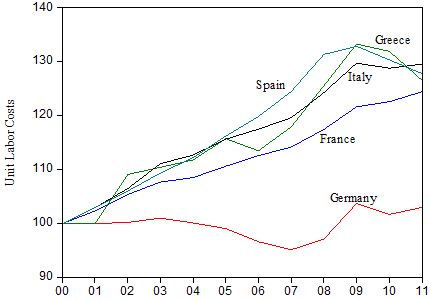| Author Name | THORBECKE, Willem (Senior Fellow, RIETI) / KATO Atsuyuki (Waseda University) |
|---|---|
| Research Project | East Asian Production Networks and Global Imbalances |
| Download / Links |
This Non Technical Summary does not constitute part of the above-captioned Discussion Paper but has been prepared for the purpose of providing a bold outline of the paper, based on findings from the analysis for the paper and focusing primarily on their implications for policy. For details of the analysis, read the captioned Discussion Paper. Views expressed in this Non Technical Summary are solely those of the individual author(s), and do not necessarily represent the views of the Research Institute of Economy, Trade and Industry (RIETI).
International Macroeconomics Program (FY2011-FY2015)
East Asian Production Network and Global Imbalances Project
Germany's exchange rate has been held down because it is linked to weaker eurozone economies. How does this affect its exports?
Results in the paper indicate that there is a very precise relationship between Germany's unit labor cost (ULC)-deflated exchange rate and its exports. A 10% appreciation of the exchange rate will reduce exports by 6%. Results also indicate that consumption goods exports respond more to exchange rate changes than do capital goods exports and that exports to other eurozone countries respond more to exchange rate changes compared to exports outside the eurozone.
Since eurozone countries share a common currency, changes in the ULC-deflated exchange rate can only come about through changes in ULC. Figure 1 shows ULC in Germany and in other eurozone countries between 2000 and 2011. For most of these countries, ULC increased by 20% to 30% over this period, but for Germany, it increased by less than 3%. Germany's ULC-deflated exchange rate thus depreciated significantly relative to its European trading partners' exchange rates.
The results imply that this large internal devaluation by Germany after adopting the euro increased capital and consumption goods exports from Germany to Europe in particular. German exports to the eurozone increased 61% for capital goods and 96% for consumption goods between 2000 and 2010. This surge in exports in turn contributed to large trade surpluses in Germany and large trade deficits in other eurozone countries.
To restore balance, wages and prices in countries such as France, Italy, and Spain will have to fall relative to those in Germany. Productivity in the deficit countries will also have to increase relative to productivity in Germany. Evidence in the paper indicates that these adjustments will have to be large. Restoring equilibrium in the eurozone is thus likely to be a long and painful process.

Figure. 1. Unit Labor Costs in Selected eurozone Countries
Source: OECD

